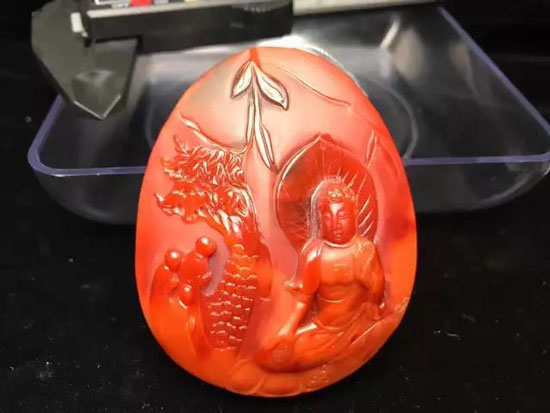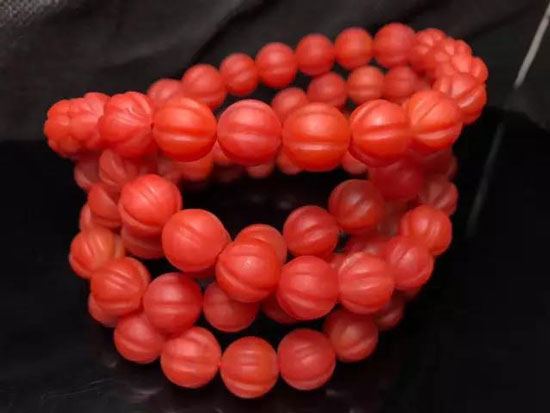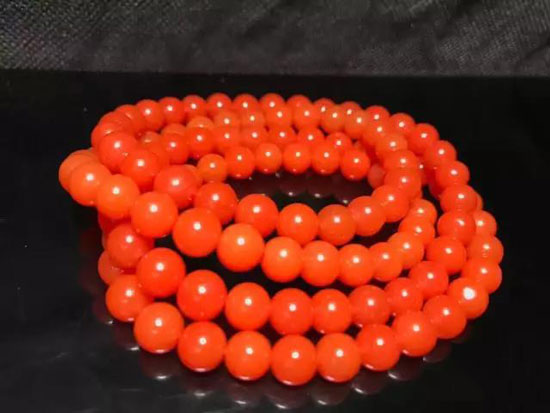So far, why is Nan Hong still so many people holding it?
Nanhong refers to a valuable variety of agate. Nanhong is named for its production in southern Xinjiang, including Yunnan, southern Sichuan, Qinghai, and Gansu. Nanhong has been exploited by people very early. Some people say that the so-called "Chiqiong" in the ancient book refers mostly to the South Red Agate. The South Red Agate is brightly colored, delicate in texture and very beautiful. It is said that during the Qing Emperor Qianlong period, the South Red Agate was extinct, and the South Red Agate that is now passed down is Han to Ming. The main production area of ​​Xinhong Nanhong is in Daliangshan in the south of Sichuan, and Baoshan in Yunnan is also produced. However, there are many fragments of Baoshan material due to fragmentation. The gem-grade minerals are mainly produced in Sichuan Liangshan Yi Autonomous Prefecture. Where is the precious? Natural color, red Yunwangcai The key to the redness of Nanhong is its natural red color. In addition, the scarcity of materials and the extremely low yield rate make Nanhong more rare. If the emerald glass of the emerald green and the fat of the hetian jade are the best in the jade, then the "Southern Red" in the agate is the "brother" jade that goes hand in hand with the above two jade articles. The hardness of South Red is similar to that of white jade and jade, with a Mohs hardness of 6.5-7. Suitable for engraving. “Nanhong†has made great efforts in investing to catch up with the fierce momentum of Jade and Hetian jade, and the wealth effect is showing up. Chinese love red is deep into the bone marrow. In the eyes of the Chinese, red is not just a representative of color. People even think that red has a supernatural exorcism effect, so red is regarded as auspicious. The Chinese people’s habit of wearing red items and the red etiquette system also highlight this cultural connotation. Scarce resources, collection treasures The high-quality Nanhong Mine was once once mined in the Qianlong period of the Qing Dynasty. Therefore, collectors can't help themselves by owning a piece of Nanhong. Therefore, the price of old South Red Agate rises every year. The ancient red agate used in ancient medicine to raise blood and nourish the heart. Believing in Buddhism believes that it has special effects. The red pearl (the true pearl) in the Buddhist seven treasures refers to the southern red agate. Now with the discovery of the high-quality Nanhong Mine in Liangshan, Sichuan, the quality of Nanhong has reached a new height in history. Nanhong in Liangshan is currently known as the best quality red red agate. Its color is gorgeous, its moisturizing degree is good, and its integrity is good. This is the advantage that Nanhong, which is not produced in any other place in history. The collection of Nanhong works has returned to the collection world, and the popularity of the South Red Collection is getting higher and higher. Material is more suitable for engraving Recently, the color of South Red Agate is more abundant. According to the color, Nanhong can be divided into Jinhong, Persimmon Red, Rose Red, Cinnabar Red, Red and White, and Red. Among them, the most traditional persimmon red, rare rose red, the color tends to be red, and the red cherry is very high in color. The re-emergence of “Nanhong†has added a dazzling radiance to the red gemstone family. Its geological strength and sensation are suitable for engraving and expression. With the emergence of high-quality Nanhong works, the integrity and craftsmanship will bring the quality of Nanhong collection to a new height. A piece of good South Red Stone to master the carving process, it is absolutely a treasure, the value is even more expensive! Southern Red History The application of the South Red Agate has a long history. In the unearthed tombs of the Warring States, there are already a series of ornaments of the South Red Agate. For example, the Yunnan Museum contains the South Red Ornaments of the Ancient Shu Kingdom Period, and the South Red Agate of the Qing Dynasty Museum of the Beijing Palace Museum. The Feng Shou Cup is more exquisite. It is a study of the South Red Agate products, the South Red Agate carvings, etc. The physical materials of the palace-grinding jade have very important historical and artistic value and are designated as national first-class cultural relics. It can be seen from these collections that the dynasties have paid great attention to Nanhong and are also rare and precious materials. It is not difficult to see from these collections that as rare and precious gemstone materials, the Southern Red Agate boutiques have been cherished by the rulers, especially in the Qing Dynasty. In recent years, with the discovery of the high-quality South Red Agate Mine in Liangshan, Sichuan, the collection of South Red Agate works has returned to the collection world, and it has revived the craze of the South Red Agate collection, attracting the attention of many collectors. As far as we know, the earliest South Pearl of the ancient Shu Kingdom was the oblate red and red ribbed pearl. In fact, this pumpkin shape was first seen in ancient Egypt, and its history in China can be traced back to the Warring States at least. It is not uncommon in the glass beads of the Ming and Qing Dynasties. The time span spans more than 2,000 years. The rest of the history is almost familiar to every South Red lover. Nanhong has officially entered the Tibetan area as a substitute for deep sea red coral. Since the red corals used in Tibetan areas are all so-called inverted corals, they are only produced in the Strait of Japan and the Taiwan Strait. The relative difficulty of trade and the preciousness of their own coral materials determine that red corals are only luxury items in the upper reaches of Tibetan areas, and the vast The people also need these red sustenances, so Nanhong really took the stage in the form of mass products and became the carry-on accessories of many believers. This situation ended early in the late Qing Dynasty. With the usual depletion of the Nanhong deposit in the late Qing Dynasty, the production of Nanhongzhuzi basically ended. Then the question comes: Nanhong is so noble and loved, what is the way to distinguish? Nanhong's identification method: Color: South red agate. Common colors are persimmon yellow of Gansu. (orange red), red, pink. There are also unusual purple, and the transparent or translucent color of these colors, including the colorless, nearly transparent, The general definition is the color range of South Red. The white texture is somewhat like the situation. There are also the textures like ribbons, which are half and half of the white and red. Here, the texture of Nanhong is very sharp, and all the lines will have a turning point. The obvious angle, (one of the important criteria for a judgment) gives a clean and sensible feeling. (That is to say red and white!) In addition to the white lines, the red color will not change other than the transparent gradient. Will be mixed with some associated minerals, black or dark green) Texture: texture, south red is colloidal. Even if the red beads are not opaque, you can see that the color is transparent from the inside to the outside, consistent. In other words, even colorless beads have The feeling of kindness, here notice, this texture is temporarily unable to falsify, unless the old material is new. So the fake South Red is basically made of pure red. Weathered pattern: On the outer surface of the beads, most of the old beads, especially the old chalcedony/manau beads, will have a half-moon-shaped weathering pattern. This pattern is mainly due to long-term use, Dzi Beads and other high-value old beads. There has been a new imitation of the weathered lines made by tapping, but it is obvious that it does not conform to the surface grout, and the size is uniform, dull, and the texture is dull (the crescent-shaped interior, the interior of the old weathered crescent is shiny) Note here that the dyed Nanhong produced in large quantities has not been weathered, and most of them are cracks on the surface of the agate made by direct high-temperature burning. Shape and patina: On the shape, there are common olive, round, pumpkin, slice, and multi-faceted beads (6 ribs, 8 ribs, 12 ribs, etc.) and various carvings, but in the market The main fake is the olive shape and the round bead. Also, note that the old beads are also worn with other beads in the use of hundreds of years, so the ends of the punched holes will have the same wear as the cut surface; Nowadays, it is found that the real beads are also dry, but it is by no means the obvious polished surface of the new imitation beads or the new work beads. The old beads are always oily and natural, (all old agate and chalcedony are common). Punching and hole: The punching of the red agate is very characteristic. It may be double-sided punching and then beading (the hole will not be small). After a long time of use, the hole is very worn. Smooth, if you find a clear spiral in the hole and a white powder, you can determine the suspected new work or dyed South Red.
Rubber bellows have versatile functions as [dust boots" or seals, used to seal out dust and other light-duty environmental factors while allowing a specific stroke or predetermined range of motion. They are quite common in industrial and automotive applications.
Rubber Bellows are used as a cover or expansion joint to protect device or machines, which are made by rubber compression molding, rubber injection mold or extrusion tool.
Rubber Bellows,Rubber Tubing ,Customized Rubber Bellows,Silicone Rubber Bellows Xiamen The Answers Trade Co.,Ltd. , https://www.xmanswers.com


